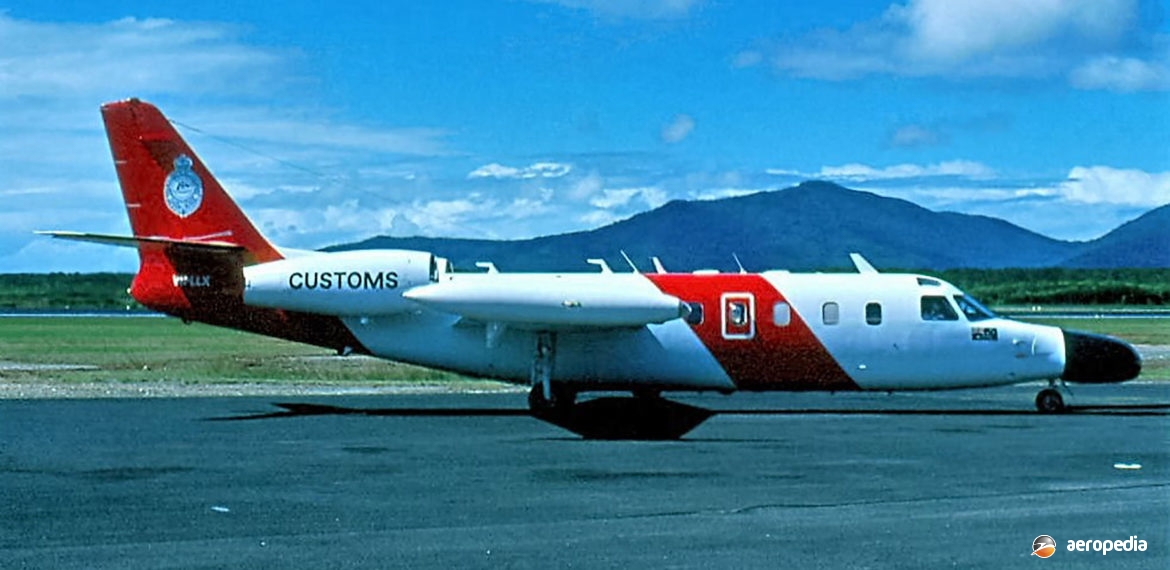Photograph:
IAI SeaScan VH-LLX (c/n 259) at Cairns, QLD in July 1991 (the late Michael Madden)
Country of origin:
Israel
Description:
Maritime surveillance aircraft
Power Plant:
Two 3,700 lbst Garrett AiResearch TFE 331-3-1G turbofans
Specifications:
- Wingspan: 13.65 m (44 ft 9½ in)
- Length: 16.8 m (55 ft)
- Height: 4.81 m (15 ft 9½ in)
- Wing area: 28.64 m² (308.26 sq ft)
- Max speed at 5,915 m (19,400 ft): 871 km/h (542 mph)
- Max operating speed at sea level: 666 km/h (414 mph)
- Endurance with standard fuel (3,951 kg / 8,710 lb): 7.5 hours
- Typical search mission: with standard fuel at low altitude at 915 m (3,000 ft) at 393 km/h (244 mph) at
- 185 km (115 miles) from base: 5.5 hours
- Empty weight: 4,667 kg (10,290 lb)
- Loaded weight: 10,365 kg (22,850 lb)
History:
In 1976 Israel Aircraft Industries (IAI) began to promote a maritime reconnaissance variant of the Westwind 1124N using experience it had gained from the Model 1123, a variant of which was developed to meet a United States Coast Guard requirement, a competition being held, but which lost out to the Dassault Falcon 20.
Initially the design of the Model 1124N was to have a ventral radome, a retractable FLIR installation, an LLTV sensor, retractable magnetometer in the rear fuselage, a searchlight in the nose, wing-tip fuel tanks, chaff dispensers and sonobuoy ejectors in the rear fuselage.
Three examples were built for the Israeli Navy in 1977 as the Model 1123, later being updated to Model 1124N SeaScan configuration by the installation of turbofan engines and some equipment changes.
In the maritime reconnaissance role the aircraft had a low-altitude endurance at search speeds of 6.1 hours and a search range of 2,428 km (1,510 miles) at 915 m (3,000 ft). The prototype SeaScan 4X-CJA (c/n 154) was the first production Commodore-Jet 1123, which later became the Westwind 1124 prototype. Surveillance equipment of the 1124N model is believed to have included Litton 504 (V) 2 search radar with a 106.7 cm (42 in) dish in the nose radome, and a Global Navigation GNS-500A series 4N navigation system.
In 1990 Skywest Aviation obtained three second-hand Westwind 1124s in the United States, which were flown to Israel where they were converted to SeaScan configuration by IAI subsidiary MATAN. They entered service in 1991. At that time Flightwest had a fleet of 42 aircraft operating from 13 bases in Australia and Papua New Guinea, and had tendered and won a contract to carry out coastal surveillance. The SeaScans operated with a crew of three. They were painted red and had “Customs” and an Australian flag painted on the fuselage. Equipment included UHF, VHF and HF radios, weather radar with ground mapping capability, VLP/Omega navigation system, bubble windows for greater vision, a homing device to locate EPIRB signals, and the ability to drop small stores.
At one stage it was announced that six SeaScans were to be imported to meet the contract for coastal surveillance on behalf of Australian Customs but in the event three were registered, these being Model 1124s VH-LLW (c/n 253), VH-LLX (c/n 259) and VH-LLY (c/n 272). They operated from Broome, WA, Darwin, NT, and Cairns, QLD, from May 1991.
Later the Australian Government called for new tenders for the contract and Amman Aviation won, but later the work was returned to Flightwest following allegations in Federal Parliament that Amman failed to fulfil the contract, this leading to a court case in the Federal Court.
In September 1996 the SeaScans were sold to Pearl Aviation Pty Ltd, withdrawn from use and broken up for spare parts at Perth, WA. It was said they had been so extensively modified for Coastwatch duties that the expense of converting them back to passenger or freight configuration was too great.

